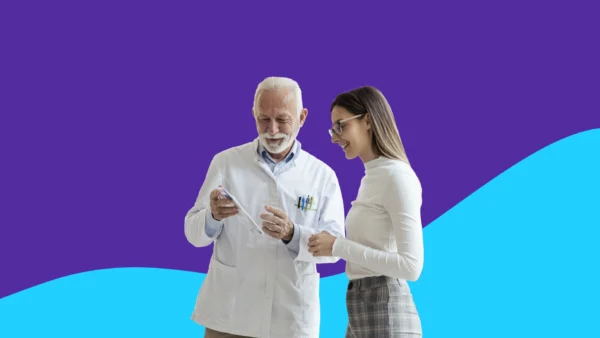“New Year, new me!”—the phrase seems to be all over social media posts on January 1. The beginning of a new year signifies a clean slate. This fresh start often motivates people to promise that they’ll do something different once the calendar flips. Popular New Year’s resolutions focus on making changes with an expectation of positive outcomes for one’s health and happiness. If weight loss is the goal, you might join a gym. If you want to kick a smoking habit, you might stock up on nicotine gum or patches.
Unfortunately, most people quickly find that willpower isn’t enough to stick with it. In fact, only 9% of people can successfully achieve their New Year’s resolutions, with an estimated 23% giving up within the first week.
How pharmacy teams can extend support
Pharmacists and pharmacy staff have an opportunity to help patients succeed in their New Year’s resolutions. Research from a 2020 study shows that people who receive support have more success completing and adhering to their resolutions than those who received no support. With 90% of Americans living within five miles of a pharmacy, pharmacists and pharmacy technicians are well-positioned to help support patients as they build healthier habits, using these tips.
1. Use motivational interviewing
When you are talking to a patient about their health goals related to sensitive topics, such as weight loss, it can be a struggle to find the right words. You want to come across as supportive, positive, and not judgmental. Motivational interviewing is a communication style that healthcare professionals can use to strengthen a patient’s internal motivation for change.
Below are examples of motivational interview questions and responses you can use to assist patients in their New Year’s resolutions.
- “You’ve made the decision to [quit smoking, get control of your finances, etc.] –that is a great first step! How can I help you achieve your goal?”
- “What worries you about giving up [fast food, cigarettes, etc.]?”
- “You said you have a goal of [losing 15 pounds, saving enough money for a vacation, etc.] in the new year. What is your next step?”
- “I know how challenging it is to [exercise for an hour every day]. What do you want to do?”
- “I understand that 20-minute walks for three days a week is a realistic plan for you.”
2. Provide smoking cessation resources
Research has found that educational intervention from a pharmacist improves outcomes in smoking cessation. Pharmacists can help patients wishing to stop smoking by familiarizing themselves with resources and therapies for smoking cessation.
Pharmacy team members can use “The 5 A’s” approach to helping patients quit smoking:
- Ask about current smoking status to determine willingness to quit. To help gauge the severity of nicotine dependence, ask how many cigarettes they smoke per day.
- Advise the patient that stopping smoking will benefit their health. Use simple language, such as, “You’ll breathe easier and have more energy if you quit smoking.”
- Assess how ready the patient is to stop smoking. To assess readiness to quit, you can ask about previous quit attempts and how ready they feel to quit smoking for good.
- Assist in recommending appropriate pharmacotherapy and interventions.
- Arrange a follow-up to see how the smoking cessation plan is going, ideally within one week.
Pharmacologic recommendations for smoking cessation
Once you know a patient wants to quit, you can help suggest the best way to quit. Pharmacists can also review medication records to ensure that smoking cessation therapies do not interact with any of the client’s current medications.
To support your patients in their attempt to quit smoking, first refresh your knowledge on current treatment guidelines. The most effective approach for smoking cessation includes pharmacotherapy in combination with behavioral counseling.
The table below summarizes first-line pharmacotherapies, including nicotine replacement therapy (NRT), for smoking cessation and what pharmacists should keep in mind when recommending them.
| Therapy | Recommendation tips |
| Nicotine patch | The nicotine patch provides a consistent nicotine level and is the easiest nicotine replacement therapy to use. Available over the counter, but many insurance plans cover NRT with a prescription. |
| Nicotine gum or lozenge | Recommend the 2 mg dose if the patient smokes their first cigarette more than 30 minutes after waking. If sooner, recommend the 4 mg dose. Available over-the-counter, but many insurance plans cover NRT with a prescription. |
| Nicotine inhaler | Nicotrol inhaler (Rx only) is appealing for some because it is an oral substitution for cigarettes, keeping the hands busy. |
| Nicotine nasal spray | Nicotrol nasal spray (Rx only) delivers rapid delivery of nicotine. |
| Varenicline | Varenicline oral tablet (Rx only) relieves withdrawal symptoms and blocks the reward from smoking. |
| Bupropion sustained-release | Bupropion sustained-release oral tablet (Rx only) may be particularly beneficial for smoking cessation in patients with depression. It may halt weight gain and can be used in combination with NRT. |
3. Recommend weight loss therapies
Weight loss is one of the most common New Year’s resolutions—and one of the hardest to achieve. To promote weight loss, pharmacists should first counsel on non-drug therapies such as healthy diet choices and increasing physical activity. Pharmacists can also review patients’ current medications to help identify medications that could be contributing to weight gain and recommend alternatives as appropriate.
BMI is used to assess the need for further intervention. Patients are considered candidates for pharmacological therapy for weight loss if they meet one of the following criteria:
- BMI greater than or equal to 30 kg/m2
- BMI of 27 to 29.9 kg/m2 with at least one weight-related comorbidity, such as Type 2 diabetes, high blood pressure, or high cholesterol.
Most weight-loss medications require a prescription, but one first line medication, Alli (orlistat 60 mg), is available over the counter. Xenical (orlistat 120 mg) requires a prescription. Be sure to counsel patients about required vitamin supplementation and the potential side effects of orlistat, such as oily spotting and fecal incontinence, especially if the drug is taken with high-fat foods.
The following agents, available by prescription, are FDA approved as adjuncts to diet and exercise for the long-term treatment of obesity:
- Adipex-P (oral phentermine)
- Contrave (oral bupropion/naltrexone)
- Subcutaneous GLP-1 agonists:
Pharmacists can help support their patients seeking weight-loss drugs by getting up-to-date on current treatment guidelines and preparing to answer patients’ questions about taking and paying for these medications, several of which can be costly.
Dietary supplements for weight loss
In general, pharmacists should not recommend dietary supplements for weight loss, as evidence showing efficacy is lacking.
Instead, pharmacists should encourage patients to invest in lifestyle changes such as a healthy, whole food diet and physical activity. For patients struggling with food access, pharmacy teams should familiarize themselves with local resources, such as food banks, to which they can refer patients in need.
Increasing physical activity for weight loss
Pharmacists can encourage physical activity to promote a healthy lifestyle for patients resolving to exercise more in the new year. Moderate exercise for 150 minutes per week or vigorous exercise for 75 minutes per week has been shown to improve cardiovascular health; exercising 225–420 minutes per week has been linked to clinically significant weight loss.
4. Help patients save money on medications
Some people have New Year’s resolutions that are not directly health-related. If an individual is choosing to focus on personal finance and saving more money, pharmacists can still support that individual. Pharmacy staff can help people save money on their medications. Suggestions include reviewing profiles for unnecessary medications, identifying less expensive alternatives, finding manufacturer coupons, and applying prescription discount cards.
Pharmacists can also save patients money in the long run by encouraging them to take their medications as prescribed. An estimated 33%-69% of medication-related hospital admissions are associated with poor medication adherence. Taking medications safely and appropriately can thus prevent expenses related to costly hospital stays.
Now is the time for pharmacists and staff to get ready to support and provide resources to patients wishing to change their habits in the new year. By practicing active listening and reviewing current evidence-based methods, pharmacists can make a difference by helping their patients build healthier habits.











